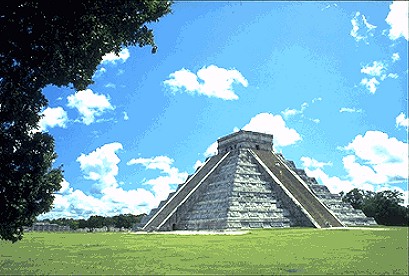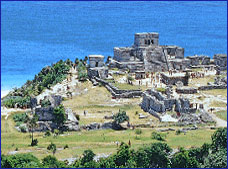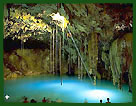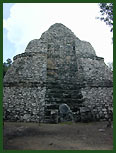|

Deep within
the jungles of Mexico and Guatemala and extending into the limestone shelf of the Yucatan peninsula lie the mysterious temples
and pyramids of the Maya. While Europe was still in the midst of the Dark Ages, these amazing people had mapped the heavens,
evolved the only true writing system native to the Americas and were masters of mathematics. They invented the calendars we
use today. Without metal tools, beasts of burden or even the wheel they were able to construct vast cities across a huge jungle
landscape with an amazing degree of architectural perfection and variety. Their legacy in stone, which has survived in a spectacular
fashion at places such as Palenque, Tikal, Tulum, Chichén Itzá, Copan and Uxmal, lives on as do the seven million descendants
of the classic Maya civilization

Tulum
This site has ruins which are characteristic
of the Post Classic period of ancient Maya civilization. Tulum has many altars, temples and shrines. Tulum was a center
for worship and religion was very important to its people. They worshipped the Descending god, a deity of the Yucatan
peninsula, and the Great Palace. The Descending god is associated with the 'setting sun', rain, lightning, and with
the planet Venus. His true identity is not certain. Tulum itself means, "fence, trench or wall," and was given this
recent name because of the wall that surrounds it. The first time this city was mentioned was in 1518 by Juan Diaz on
Juan de Grijalva's expedition. This Mayan site was used by rebels at various times because of its protective walls.
In 1871, Tulum became a sanctuary for Maris Uricab, who led the "Speaking Cross" cult and was known as the queen of Tulum.
Archeology.

CHICHEN ITZA
SITE DESCRIPTION
Introduction
A brief description by the Unesco states: This site is one of the most impressive testimonies to the Maya-Toltec civilization
of the Yucatan (10th To 15th centuries).
It contains some of the most outstanding examples of Central American architecture, combining Maya construction techniques
and Toltec sculpted decoration.
Chichen Itza
means mouth of the well and covers about 5 km. in area
and was built in the late Classic Period (800-1000 AD). It is a magical place with the massive Pyramid of Kukulcan (El Castillo)
being the centerpiece.

Coba
Nestled
in the Yucatán thick jungle and surrounded by exquisite lakes nearby is the once great city of Coba. Its name means “water
stirred by wind” and started to become a major independent community at the time Roman legions were on their way to
building an empire. The city flourished between 600-900AD and by the end of the Classic period, it had become a major Maya
city-state with a population of about 60,000 inhabitants. Archeologists have discovered many links, including similar architecture
carvings, decorations, to the great Maya city of Tikal (Guatemala) and it is believed that noble and royalty from both cities
married in order to strengthen political power. Its control over the Yucatan trade routes gave the city a commercial sphere
of influence aiding it to thrive. During the PostClassic (1000-1200 AD) Coba lost its dominance to cities like Tulum as its
political and commercial influence crumbled. If you have a chance of visiting Coba you will discover what may have been one
of the largest of all Maya cities.
|

